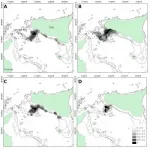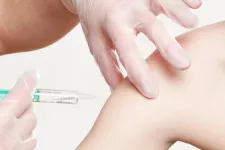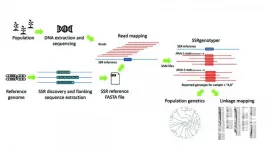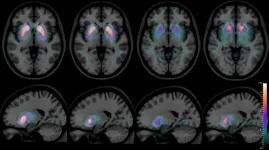(Press-News.org) Neanderthals' gut microbiota already included some beneficial micro-organisms that are also found in our own intestine. An international research group led by the University of Bologna achieved this result by extracting and analysing ancient DNA from 50,000-year-old faecal sediments sampled at the archaeological site of El Salt, near Alicante (Spain).
Published in Communication Biology, their paper puts forward the hypothesis of the existence of ancestral components of human microbiota that have been living in the human gastrointestinal tract since before the separation between the Homo Sapiens and Neanderthals that occurred more than 700,000 years ago.
"These results allow us to understand which components of the human gut microbiota are essential for our health, as they are integral elements of our biology also from an evolutionary point of view" explains Marco Candela, the professor of the Department of Pharmacy and Biotechnology of the University of Bologna, who coordinated the study. "Nowadays there is a progressive reduction of our microbiota diversity due to the context of our modern life: this research group's findings could guide us in devising diet- and lifestyle-tailored solutions to counteract this phenomenon".
THE ISSUES OF THE "MODERN" MICROBIOTA
The gut microbiota is the collection of trillions of symbiont micro-organisms that populate our gastrointestinal tract. It represents an essential component of our biology and carries out important functions in our bodies, such as regulating our metabolism and immune system and protecting us from pathogenic micro-organisms.
Recent studies have shown how some features of modernity - such as the consumption of processed food, drug use, life in hyper-sanitized environments - lead to a critical reduction of biodiversity in the gut microbiota. This depletion is mainly due to the loss of a set of microorganisms referred to as "old friends".
"The process of depletion of the gut microbiota in modern western urban populations could represent a significant wake-up call," says Simone Rampelli, who is a researcher at the University of Bologna and first author of the study. "This depletion process would become particularly alarming if it involved the loss of those microbiota components that are crucial to our physiology".
Indeed, there are some alarming signs. For example, in the West, we are witnessing a dramatic increase in cases of chronic inflammatory diseases, such as inflammatory bowel disease, metabolic syndrome, type 2 diabetes and colorectal cancer.
HOW THE "ANCIENT" MICROBIOTA CAN HELP
How can we identify the components of the gut microbiota that are more important for our health? And how can we protect them with targeted solutions? This was the starting point behind the idea of identifying the ancestral traits of our microbiota - i.e. the core of the human gut microbiota, which has remained consistent throughout our evolutionary history. Technology nowadays allows to successfully rise to this challenge thanks to a new scientific field, paleomicrobiology, which studies ancient microorganisms from archaeological remains through DNA sequencing.
The research group analysed ancient DNA samples collected in El Salt (Spain), a site where many Neanderthals lived. To be more precise, they analysed the ancient DNA extracted from 50,000 years old sedimentary faeces (the oldest sample of faecal material available to date). In this way, they managed to piece together the composition of the micro-organisms populating the intestine of Neanderthals. By comparing the composition of the Neanderthals' microbiota to ours, many similarities aroused.
"Through the analysis of ancient DNA, we were able to isolate a core of microorganisms shared with modern Homo sapiens", explains Silvia Turroni, researcher at the University of Bologna and first author of the study. "This finding allows us to state that these ancient micro-organisms populated the intestine of our species before the separation between Sapiens and Neanderthals, which occurred about 700,000 years ago".
SAFEGUARDING THE MICROBIOTA
These ancestral components of the human gut microbiota include many well-known bacteria (among which Blautia, Dorea, Roseburia, Ruminococcus and Faecalibacterium) that are fundamental to our health. Indeed, by producing short-chain fatty acids from dietary fibre, these bacteria regulate our metabolic and immune balance. There is also the Bifidobacterium: a microorganism playing a key role in regulating our immune defences, especially in early childhood. Finally, in the Neanderthal gut microbiota, researchers identified some of those "old friends". This confirms the researchers' hypotheses about the ancestral nature of these components and their recent depletion in the human gut microbiota due to our modern life context.
"In the current modernization scenario, in which there is a progressive reduction of microbiota diversity, this information could guide integrated diet- and lifestyle-tailored strategies to safeguard the micro-organisms that are fundamental to our health", concludes Candela. "To this end, promoting lifestyles that are sustainable for our gut microbiota is of the utmost importance, as it will help maintain the configurations that are compatible with our biology".
INFORMATION:
THE AUTHORS OF THE STUDY
The study titled "Components of a Neanderthal gut microbiome recovered from fecal sediments from El Salt" was published in Communication Biology. The University of Bologna participated in this study thanks to Marco Candela, Simone Rampelli, Silvia Turroni and Elena Biagi from the Department of Pharmacy and Biotechnology; Annalisa Astolfi from the Interdepartmental Center for Cancer Research "Giorgio Prodi"; Patrizia Brigidi from the Department of Medical and Surgical Sciences; and Stefano Benazzi from the Department of Cultural Heritage.
Moreover, this study saw the participation of researchers from the Universidad de La Laguna (Spain), from the Massachusetts Institute of Technology (USA) as well as the University of Oklahoma (USA) and Konrad Lorenz Institute for Evolution and Cognition Research (Austria).
New research has identified a nanostructure that improves the anode in lithium-ion batteries
Instead of using graphite for the anode, the researchers turned to silicon: a material that stores more charge but is susceptible to fracturing
The team made the silicon anode by depositing silicon atoms on top of metallic nanoparticles
The resulting nanostructure formed arches, increasing the strength and structural integrity of the anode
Electrochemical tests showed the lithium-ion batteries with the improved silicon anodes had a higher charge capacity and longer lifespan
New research conducted by the Okinawa Institute of Science and Technology ...
USC researchers have developed a new method to counter emergent mutations of the coronavirus and hasten vaccine development to stop the pathogen responsible for killing thousands of people and ruining the economy.
Using artificial intelligence (AI), the research team at the USC Viterbi School of Engineering developed a method to speed the analysis of vaccines and zero in on the best potential preventive medical therapy.
The method is easily adaptable to analyze potential mutations of the virus, ensuring the best possible vaccines are quickly identified -- solutions that give ...
The early prognosis of high-risk older adults for amnestic mild cognitive impairment (aMCI), using noninvasive and sensitive neuromarkers, is key for early prevention of Alzheimer's disease. A recent study, published in the Journal of Alzheimer's Disease, by researchers at the University of Kentucky establishes what they believe is a new way to predict the risk years before a clinical diagnosis. Their work shows that direct measures of brain signatures during mental activity are more sensitive and accurate predictors of memory decline than current standard behavioral testing.
"Many studies have measured electrophysiological rhythms during resting and sleep ...
Scientists at Tokyo Institute of Technology (Tokyo Tech) and NTT Corporation (NTT) develop a novel CMOS-based transceiver for wireless communications at the 300 GHz band, enabling future beyond-5G applications. Their design addresses the challenges of operating CMOS technology at its practical limit and represents the first wideband CMOS phased-array system to operate at such elevated frequencies.
Communication at higher frequencies is a perpetually sought-after goal in electronics because of the greater data rates that would be possible and to take advantage of underutilized ...
A new study in Frontiers in Marine Science provides a first-of-its-kind evaluation of which regions of southern European seas are in the most need of fishing restrictions. These areas have persistently shown high numbers of undersized fish and crustaceans, which are typically discarded because they are below the allowable size limit for collection. These findings may offer a strategy for prioritizing conservation efforts and ensuring more sustainable fishery management in the future.
"Natural fish populations need time to reproduce and recover from fishing impacts -- this is the only way to achieve a balance between natural resources and human exploitation," says lead author Dr Giacomo Milisenda, of the Stazione Zoologica Anton Dohrn di Napoli in ...
Multidisciplinary team of international experts suggests participants should receive a "substantial" amount, be paid ethically
Healthy people volunteering to be infected with SARS-CoV-2, in order to help scientists better understand how to tackle the virus, should receive payment - if it is determined that these studies are otherwise ethical to proceed.
Those are the findings of a new peer-reviewed study published in the American Journal of Bioethics, which has assessed the ethics of paying participants to take part in so-called 'Human Infection Challenge Studies' (HICS).
Over ...
SSRgenotyper is a newly developed, free bioinformatic tool that allows researchers to digitally genotype sequenced populations using simple sequence repeats (SSRs), a task that previously required time-consuming lab-based methods.
Reporting in a recent issue of Applications in Plant Sciences, the tool's developers designed the program to seamlessly integrate with other applications currently used for the detection and analysis of SSRs.
Simple sequence repeats are short chains of repeating nucleotides that are prone to mutation. The variability of these DNA sequences makes them ideal for genetic analyses to distinguish between individuals and are often the marker of choice for paternity and forensic testing.
In research fields, SSRS have ...
American actor Robin Williams had a neurodegenerative brain disease called dementia with Lewy bodies (DLB): a distressing disease, with symptoms in common with Alzheimer's disease (AD) and Parkinson's disease (PD). But unlike these two conditions, DLB also entails prominent mood and cognitive swings, sleep disorders, and vivid, sometimes terrifying, visual hallucinations. It is now thought that Robin Williams, whose diagnosis was only ascertained post-mortem, was likely driven to suicide, in 2014, by the terrifying hallucinatory experiences he suffered for years - and about which he never told anyone, not even his wife. Susan Schneider Williams recounted the tragic story in an editorial published in the journal ...
As a new presidential administration takes steps to examine options to control the spread of COVID-19 through increased testing, epidemiologists at The University of Texas at Austin and other institutions have a new analysis that shows the value of having all people in the U.S. tested on a regular, rotating basis to slow the spread of the novel coronavirus and the loss of life from COVID-19. The team's model is outlined in a paper published online today in The Lancet Public Health.
With the introduction of accurate and inexpensive rapid tests, researchers say there is an optimal testing schedule that minimizes costs as well ...
Weekly COVID-19 testing, with two-week isolation of positive cases, is the most cost-effective strategy to mitigate spread of the virus in the USA when transmission is high in affected areas until vaccines are widely available.
When transmission rates are low to moderate, monthly testing and a one-week isolation period is the most cost-effective approach.
Monthly population testing is more cost-effective than the current strategy of testing only people showing symptoms and their close contacts.
Weekly COVID-19 testing, coupled with a two-week isolation period for positive cases, may be the most cost-effective strategy to tackle the ...





